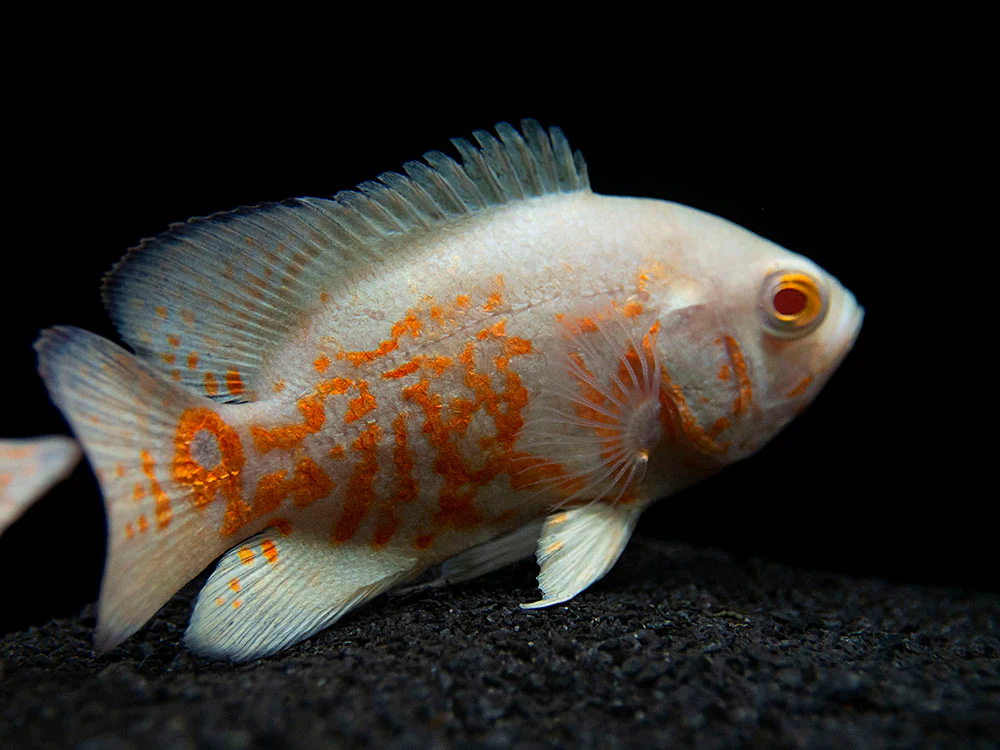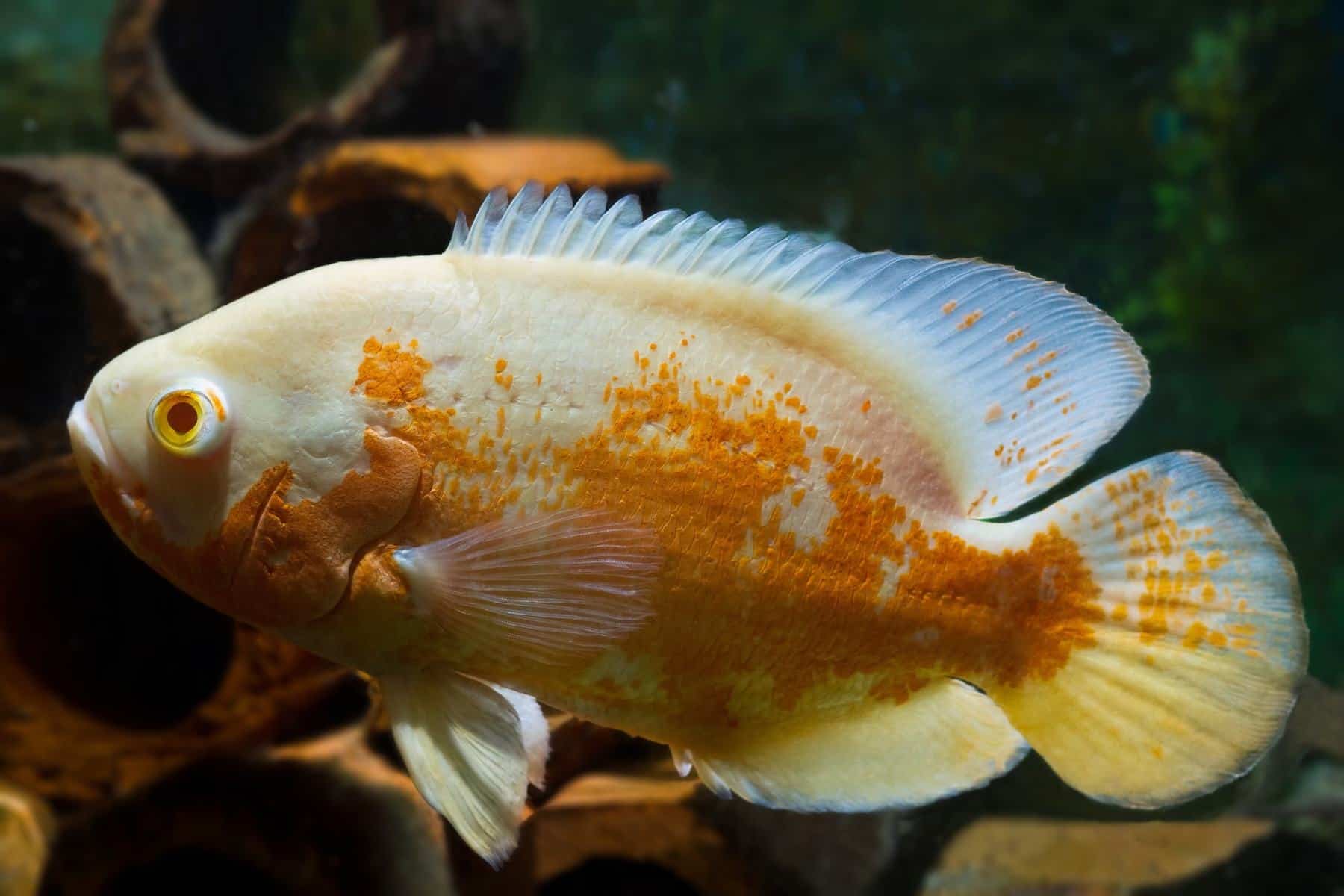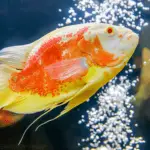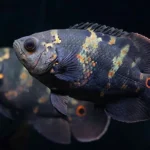Oscar fish, specifically the white variety, are a unique addition to the freshwater aquarium community, combining striking appearance with an engaging personality. Often admired for their vibrant white coloration, these freshwater fish have garnered significant attention from aquarists around the world. Due to their size and distinctive behaviors, white Oscars demand particular care, setting them apart from other aquarium inhabitants.

Understanding the needs of white Oscar fish is critical for those interested in keeping them as pets. Their growth to a substantial size necessitates a spacious aquarium, while their interaction with the environment and other fish can present both challenges and delights for the aquarist. These fish are not only known for their robustness but also for their complex behaviors, which can range from territorial display to unique feeding antics.
Key Takeaways
- White Oscar fish are captivating aquarium pets that require an understanding of their specific care needs.
- They exhibit distinctive behaviors and need ample space due to their potential size.
- Providing an appropriate environment and monitoring health are key to successful Oscar fish keeping.
Scientific Classification and Origin

In this section, we explore the scientific classification and origins of the Oscar fish, providing insights into its taxonomic placement and the natural environments from which it originates.
Taxonomy and Scientific Name
The Oscar fish is scientifically named Astronotus ocellatus. Its classification is as follows:
- Kingdom: Animalia
- Phylum: Chordata
- Class: Actinopterygii
- Order: Cichliformes
- Family: Cichlidae
- Genus: Astronotus
- Species: A. ocellatus
Natural Habitat and Geographic Distribution
Astronotus ocellatus, commonly known as the Oscar fish, is indigenous to South America. Its natural habitat spans a range of freshwater environments, including:
- The Amazon River basin
- Flowing waters and floodplain lakes across Brazil
- The network of rivers and tributaries in Peru
- Freshwater bodies found in Venezuela
Our understanding is that this species thrives in a diverse array of aquatic locales, demonstrating a preference for warm, slow-moving, or stagnant waters that offer a rich array of substrates and cover.
Physical Characteristics

In this section, we will discuss the distinctive color variations and markings of White Oscar Fish, as well as their size and overall appearance.
Color Variations and Markings
White Oscars are a type of aquarium fish known for their striking coloration. They can come in several varieties, such as:
- Albino Oscars: These fish are distinguished by their lack of pigment, resulting in a pale white or pinkish appearance.
- Tiger Oscars: Characterized by their vibrant patterning, they often have a mix of orange, black, and white.
- Velvet Cichlid: This is another name for Oscars due to their smooth and soft-looking skin, which can be white in some individuals.
- Marble Cichlid: They showcase a mix of colors and patterns, including white.
These colors and patterns often vary greatly from fish to fish, making each Oscar unique.
Size and Appearance
Oscars are sizeable cichlids, with adults typically reaching:
- Length: 12 to 14 inches (30 to 35 cm)
- Weight: Up to 3.5 pounds (1.6 kg)
Their appearance is characterized by a large, oval-shaped body and a broad head. White Oscars specifically may have the following traits:
- Color: A solid white or a mix with other colors
- Markings: White Oscars can still have markings of other colors, though less intense than their darker counterparts.
It’s important to note that variations like the Red Oscar and Black Oscar do not necessarily apply to the White Oscar, whose main defining characteristic is their white-based coloration.
Behavior and Temperament
We must understand that the behavior and temperament of white Oscar fish are pivotal to their care. These fish are known for their unique personalities and intelligent behavior, which can both enrich and challenge an aquarium environment.
Territorial and Social Behaviors
White Oscar fish exhibit a strong sense of territory within their environment. We often observe them claiming particular areas of the tank, especially when they have an established setup with rocks and other decorations. Their territorial nature means they can become aggressive if they feel their space is being invaded by other fish or even by the aquarium owner during maintenance tasks.
In terms of social behaviors, Oscars can be quite interactive with their owners. They’re capable of recognizing individuals and may even engage in playful activities, which is a testament to their intelligence. However, it’s crucial to note that their social interactions are primarily with humans, as inter-species relationships can often lead to conflicts due to their assertive nature.
Compatibility with Tank Mates
When considering tank mates for white Oscar fish, one must be cautious. Their aggressive tendencies can be problematic when housing them with other fish. Compatibility is largely dependent on the size and temperament of potential tank mates.
Suitable Tank Mates:
- Large, robust fish: Species that can hold their own without being aggressive.
- Similar sized Oscars: As long as the tank is sufficiently large to accommodate their territorial needs.
Unsuitable Tank Mates:
- Small, docile fish: Likely to become targets of aggression.
- Very aggressive species: Can lead to constant conflict and stress.
We ensure proper tank management and consider the personalities of individual Oscars, as variations can exist. Through attentive observation and responsive care, we can facilitate a more harmonious community within the aquarium.
Aquarium Care and Conditions
Proper aquarium care and setup are instrumental in maintaining the health and well-being of white Oscar fish. We’ll cover the essentials spanning from tank setup to diet, ensuring a suitable environment for these charismatic creatures.
Tank Requirements and Setup
For housing white Oscar fish, we recommend a minimum tank size of 75 gallons, as Oscars can grow to a considerable size, often reaching up to 12 inches in length. The substrate should ideally be coarse gravel or sand, which facilitates easy cleaning and mimics their natural habitat. It’s beneficial to include various rocks and plants, which provide hiding places and reduce stress, but ensure they are secure to prevent injury.
- Minimum Tank Size: 75 gallons
- Substrate: Coarse gravel or sand
- Decoration: Rocks, driftwood, sturdy plants
Water Conditions and Filtration
Maintaining optimal water conditions is non-negotiable for white Oscar fish. We aim for a pH level between 6.5 and 7.5 and a water temperature of 74-81°F (23-27°C). Consistent water quality is key, which necessitates a robust filtration system. A canister or a sump filter with biological, chemical, and mechanical media will help manage the bioload produced by these large fish.
- pH Level: 6.5 – 7.5
- Temperature: 74-81°F (23-27°C)
- Filtration: Canister or sump filter with multi-stage media
Diet and Feeding
White Oscars are not particularly picky eaters, yet their diet should be varied and nutritionally balanced. A mix of high-quality pellets should serve as the staple of their diet, supplemented with live foods such as bloodworms and brine shrimp. Occasional treats can include insects, meat, and small crustaceans to provide essential proteins and mimic natural feeding behaviors. Feed them twice daily with amounts they can consume within a few minutes to avoid overfeeding.
- Staple Diet: High-quality pellets
- Supplements: Live foods (bloodworms, brine shrimp)
- Feeding Frequency: Twice daily
Health and Breeding
Maintaining the health of Oscar fish and understanding their breeding patterns is crucial for keeping them in an aquarium setting. We’ll look at common illnesses these fish face and how to treat them, as well as their breeding behavior and the subsequent care for their young.
Common Diseases and Treatment
Ich (White Spot Disease)
- Symptoms: White spots on the skin, gills, and fins of the fish.
- Treatment: Raise the tank temperature gradually to 86°F for three days and add aquarium salt or use an Ich treatment medication.
Velvet Disease
- Symptoms: Yellowish or gold dust appearance on the skin, clamped fins, difficulty breathing, and lethargy.
- Treatment: Increase the tank temperature, reduce light, and use a copper-based medication.
Hole in the Head Disease
- Symptoms: Pits or holes on the head and frontal area.
- Treatment: Improve water quality, provide a balanced diet, and consider adding antibiotics if bacterial infection is suspected.
Fin Rot
- Symptoms: Frayed or disintegrating fins, often with a red tinge.
- Treatment: Improve tank cleanliness, add aquarium salt, and antibiotic treatments if it is severe.
Maintaining a clean and safe environment is vital for prevention and recovery from these diseases.
Breeding Habits and Fry Care
Breeding
- Identification: Sexing Oscars can be challenging; however, during breeding, females have a protrusion on their genital papilla.
- Environment: Breeding Oscars require a spacious tank with a flat surface for laying eggs, such as a large stone or a piece of slate.
Fry Care
- Post-Hatching: After hatching, fry should be kept in a separate rearing tank.
- Feeding: Start with brine shrimp nauplii or commercially available fry food.
- Protection: A secure lid is essential to prevent the parents from jumping out during the breeding period.
We must ensure the water conditions are pristine and stable to support the health of both adult Oscars and fry.
Frequently Asked Questions
When it comes to Oscar fish, we often encounter a set of common questions from aquarists and enthusiasts. In this section, we aim to provide clear and concise answers to these queries, particularly focusing on size, care level, characteristics, scientific classification, coloration, and purchase advice.
What is the average size of an adult Oscar fish?
The average size of an adult Oscar fish is typically around 12 inches in length, but they have been known to reach up to 14 inches in a well-maintained aquarium.
Can Oscar fish be kept easily by beginners?
Oscar fish are not the easiest species to keep and may not be suitable for beginners. They require a large aquarium, frequent water changes, and specific water parameters, which might be challenging for novice aquarists to maintain.
What are the unique characteristics of Albino Oscar fish?
Albino Oscar fish lack melanin, giving them their distinctive white or pink color with red eyes. They also share the same behavioral traits as other Oscars, such as recognizing their owners and exhibiting playful behavior.
What is the scientific name of the Oscar fish species?
The scientific name for the Oscar fish species is Astronotus ocellatus.
How does the Oscar fish’s color variation affect its care requirements?
While color variations like those found in Tiger Oscars or Albino Oscars do not significantly change their care requirements, all Oscars need similar levels of care regarding water quality, diet, and tank size.
Where can one purchase healthy Oscar fish?
Healthy Oscar fish can be purchased from reputable aquarium shops, professional breeders, or online retailers that specialize in cichlids. It is crucial to buy from sources that provide fish with proper care and valid health certificates.






